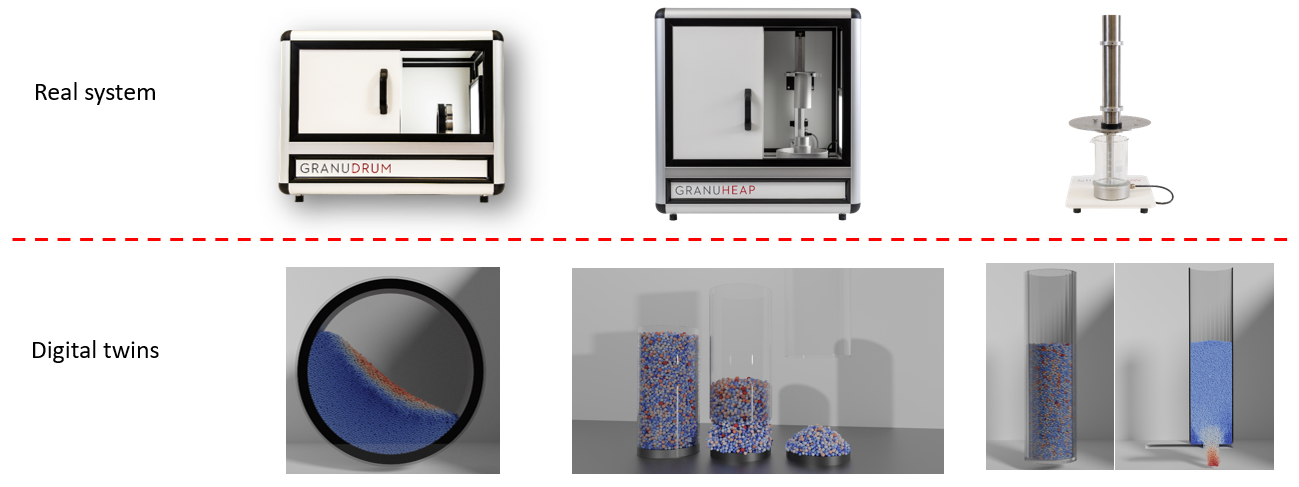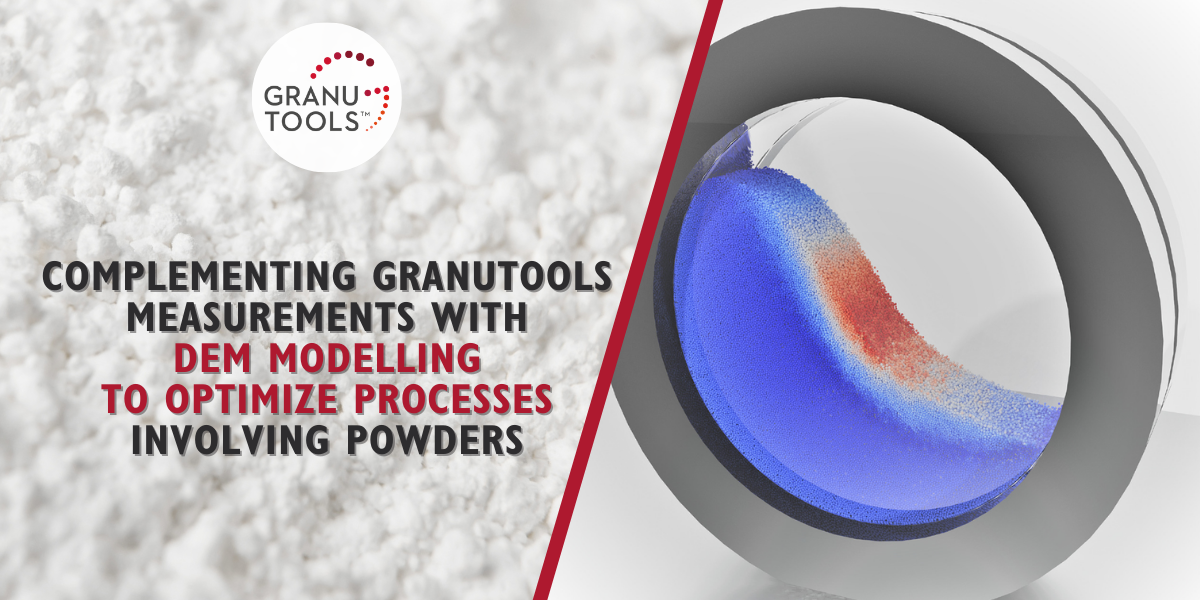Blog
Complementing Granutools measurements with DEM modelling to optimize processes involving powders
In this article, we show how DEM simulations can help to better understand powder flow measurement and how to cross the bridge between the laboratory measurement and processes optimization in the production plant.
Introduction: Integrating DEM Modelling with Powder Flow Measurements
A complete powder characterization requires the association of different measurements leading to a set of metrics (cohesiveness, angle of repose, dynamic angle of repose, density, electrostatic charge, rheological indexes, …). Granutools offers a range of instruments dedicated to that purpose. As it would be time-consuming and expensive to systematically perform the complete set of measurements, the characterization techniques must be selected smartly according to the application or to the process. Granutools offers a set of application notes available on its website to help you make this choice. Once the parameters are measured, an interpretation of these results in relation to the application or to the process is necessary. It is at this stage that simulations can help using the concept of digital-twins.
In parallel to a continuous improvement process for the laboratory instruments and to the development of new functionalities, Granutools developed digital-twins using Discrete elements methods (DEM), a widely adopted method to simulate particulate systems. A digital-twin is the digital counterpart of a physical device. In the field of powder technology, the physical device is the powder characterization method or the process in the production plant.
The digital-twins can help on three levels: The first level is the DEM parameters calibration, an unavoidable step. The second level is the improvement of the understanding of powder behaviour inside the measurement device to go further than the analysis of the parameters given by the instrument. The last and highest level is the simulation of the process.
LEARN MORE ABOUT OUR INSTRUMENTS
Digital-twins for DEM calibration and validation
The contact models used in DEM are always a simplification of the contacts in a real material. Moreover, the determination of the contact parameters is a difficult task, in particular for fine cohesive powders. To overcome this difficulty, top-bottom calibration approaches have been developed, in which the parameters are determined so that the simulated macro behaviour matches the one of the real powder. In other words, the results obtained with these laboratory instruments are compared with the numerical results obtained with the corresponding digital-twins. An optimization method is used to converge towards the best set of DEM parameters corresponding to the powder.
Digital-twins to improve powder behaviour understanding
Performing a powder flow measurement gives macroscopic parameters. For example, GranuDrum gives the dynamic angle of repose and the powder cohesive index, GranuHeap gives the angle of repose, GranuPack measures the packing dynamics, … These macroscopic indexes are extremely useful to characterise powder flow, to follow the batch-to-batch stability, or to check the properties of a raw material before processing it. However, for high-end applications, a deeper understanding is necessary. Using the laboratory instrument digital-twins in parallel with the physical measurements allows to obtain additional information like the velocity profile in GranuDrum for a deeper rheological analysis, an analysis of the heap formation in GranuHeap or the vertical packing fraction profile in GranuPack. Complex mechanisms like segregation or agglomeration can also be investigated.

Digital-twins to optimise the process
DEM simulations are more and more used to simulate real industrial systems to optimise the processes. However, an accurate representation of the material behaviour is essential to gather insights transferable to the real process. By performing the calibration step with the characterization instruments and their digital-twins, a set of DEM simulation parameters that match the real powder properties is obtained. This set of parameters can be used to simulate the process with, in this case, the digital-twin of the process. This way, a process optimization study can be done by simply varying the process parameters in the simulation, providing huge time and cost saving. This approach can be applied to any kind of process. It has been already used with success to better understand and to improve powder spreadability in powder bed based additive manufacturing processes.
Conclusion: Powder characterization must be consistent with the process
To be valuable for industries, powder characterization must be consistent with the process. The characterization method and geometry have to be selected cleverly. Moreover, DEM simulations can help to fill the gap between the measurement results and the process optimization. The strategy of Granutools is based on the development of digital-twins of both the laboratory instruments and the process.
Do you have questions about powder characterization ?

 (1).png)